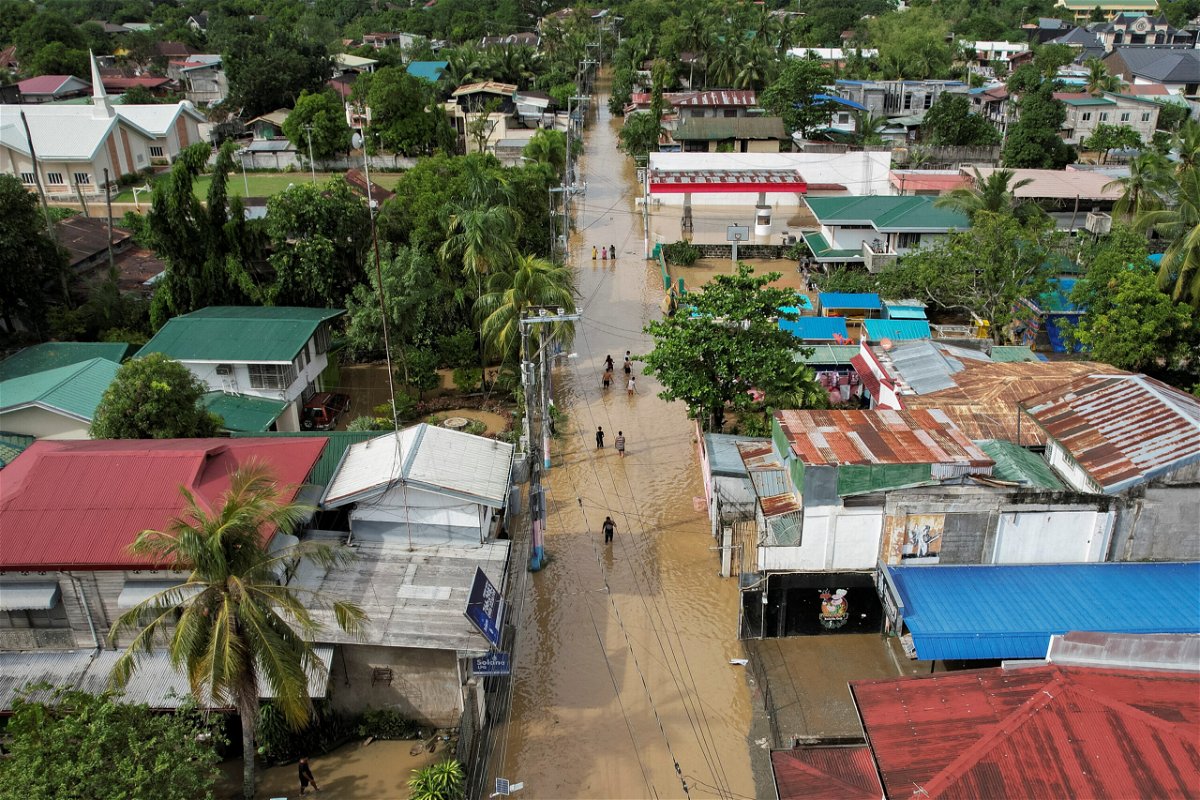Typhoon Noru smashes into the Philippines, killing 5 and leaving villages in tatters

Residents wade through submerged streets after Typhoon Noru in San Miguel
By Jessie Yeung and Jan Camenzind Broomby, CNN
People in the northern Philippines were bracing for landslides on Monday after five rescue workers were killed in the aftermath of Typhoon Noru, which made landfall on Sunday and is now heading for Vietnam.
The typhoon, known locally as Typhoon Karding, intensified rapidly from Saturday to Sunday, arriving as a super typhoon at its peak of around 160 miles per hour (more than 250kph).
The typhoon gathered power incredibly quickly, going from the equivalent of a Category 1 hurricane to Category 5 in just six hours. The stronger the wind speed of a typhoon or hurricane, the more powerful it is and destructive it’s likely to be. The rapid intensification right before landfall likely meant locals had little, if any, time to prepare for the much stronger storm.
It blasted the main island of Luzon on Sunday, before weakening Monday to a Category 2-equivalent typhoon, according to the US Joint Typhoon Warning Center. The storm is picking up strength again, however, as it approaches Vietnam.
The bodies of the five rescue workers killed have been recovered in the country’s northern Bulacan province, according to Richard Gordon, chair of the Philippines Red Cross. He said landslides were expected in more rural and mountainous regions, adding to the fear of further casualties.
‘People don’t know how to start their lives again’
Willard Macaranas, owner of the PacifiKhulas Transient House hotel in Barangay Umiray, a town in Aurora province, told CNN how he “hid for safety” as the typhoon approached Sunday.
He said the feeling was “indescribable,” and that he could only “pray” as he heard the sound of the wind and the rain upon his roof.
Macaranas shared photos of the damage the typhoon caused to his hotel, showing parts of the facade torn off and the outer staircases damaged.
It will be “difficult to start again right now,” he said, and expects the damage to take three months to repair. “I’m worried what future calamities might happen to the business. But we have no choice.”
Macaranas described the destruction he saw along the coastline, with houses and electricity lines torn down.
“It hurts to see. People don’t know how to start their lives again,” he said. “I can see the pain in their eyes, and the big questions of how to get enough money to build a small home, or how to buy a new boat to fish again.”
Photos from Luzon show residents wading through chest-level floodwater to carry their belongings from their submerged homes.
Others showed rows of tents set up in schools and gymnasiums being used as evacuation centers, where 13,600 families retreated to avoid the flooding, Gordon said. Images and video from the island show destroyed houses and debris littering the road.
So far, the Red Cross has mobilized 2,000 volunteers in the affected areas to provide food and other relief supplies.
Schools and businesses were closed in Luzon on Monday, and President Ferdinand Marcos ordered supplies to be airlifted and clean-up equipment provided to most-affected communities.
“The point at which we can stand down is when the majority of evacuees are already back home,” Marcos said at a news conference with disaster management officials on Monday.
Noru is now moving away from Luzon island and is forecast to re-intensify before it makes landfall over Vietnam on Tuesday.
Luzon, which accounts for more than two-thirds of the economy and roughly half of the country’s 110 million population, started clean-up operations as floods in the capital region had started subsiding, officials said.
Marcos, who will conduct an aerial inspection later on Monday, also ordered officials to provide emergency power supply to two provinces north of the capital, Aurora and Nueva Ecija, which were left without electricity.
Multiple regions were “impacted by internet outages corresponding to power cuts after super typhoon Noru makes landfall,” according to internet connectivity monitoring service Netblocks.
The-CNN-Wire
™ & © 2022 Cable News Network, Inc., a Warner Bros. Discovery Company. All rights reserved.
CNN’s Christian Edwards and Brandon Miller contributed reporting. Additional reporting from Reuters.